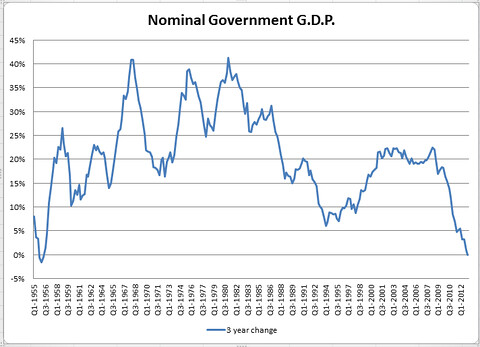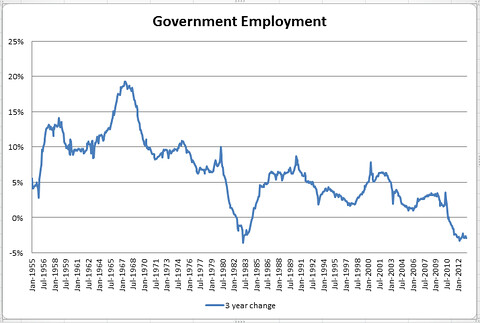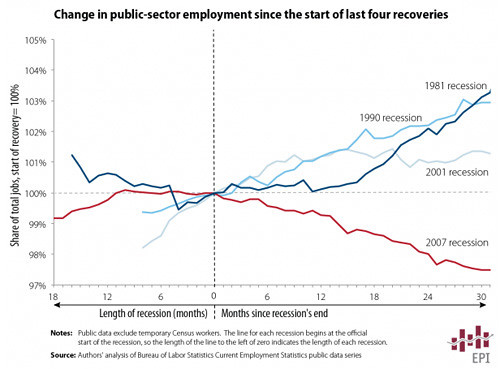Friday's news that U.S. gross domestic product grew by only 2.5 percent came as a disappointment. After all, that performance not only fell short of the consensus expectation of three percent GDP growth, but was aided by a one-time bump for inventory expansion deferred from the last quarter of 2012. And while the strengthening housing market was a bright spot, those gains were offset by the contraction of government spending that on average has slashed half a point off GDP each quarter since early 2010. As it turns out, after years of austerity by state and local governments, Uncle Sam, too, is holding back U.S. economic growth.
As Floyd Norris explained in the New York Times, the U.S. hasn't seen this kind of contraction since the post-Korean War demobilization of the mid-1950's:
The G.D.P. report released Friday states the total government part of G.D.P. - federal, state and local - came to $3.0306 trillion in the first quarter of this year. That is 0.01 percent below the $3.0309 trillion recorded four years earlier.
Those are nominal figures, not adjusted for inflation...On a real basis, the decline was 6.5 percent.
And that kind of drag, Jared Bernstein warned, is offsetting the double-digit expansion the housing sector has enjoyed for three straight quarters:
Housing continues to be a bright spot as residential investment was up almost 13% on an annual basis. Housing has now been a positive contributor to growth for two-years running, adding 0.3% to the 2.5% growth rate for the first quarter.
But the government sector more than offset housing's contribution, shaving 0.8% off of the growth rate, with across the board declines in defense, non-defense, and state and local public spending. Since 2010q1, the public sector has, on average, taken half-a-percent from real GDP growth per quarter.
In February, the Congressional Budget Office warned that the $1.2 trillion, decade-long budget sequester could reduce economic growth by 0.6 percent and result in the loss of 750,000 jobs in 2013 alone. As the Economic Policy Institute suggested, Friday's GDP numbers may reflect the first signs of that impact:
Both federal and state and local government spending contracted in the first quarter. The fingerprints of contractionary fiscal policy are evident in this report. The drag from federal government spending cuts was predictable, as was the decline in disposable personal income (discussed in greater detail below) stemming from the expiration of the temporary payroll tax cut (with no offsetting stimulus to replace it). Defense spending fell rapidly again, contracting by 11.5 percent as compared with the previous quarter's 22.1 percent contraction. But non-defense spending also fell this quarter, contracting by 2.0 percent. State and local spending contracted by 1.2 percent. Hopes for an end to the state and local drag on growth seem now to have been premature.
That last point was echoed in the New York Times. Despite the improving revenue situation in the states, there is not much reason to expect it to counter the debilitating impact of Uncle Sam's belt-tightening:
In the first quarter of this year, government spending fell at an annual rate of 8.4 percent, after a decrease of 14.8 percent in the fourth quarter of 2012 -- with both declines happening before the March start of the sequester. Mr. Dales said the only reason to hope that the bite from the sequester will be less painful than some fear is that state and local tax revenues have risen in the last year, so those governments might be able to stem the tide of their cuts and potentially even increase spending again.
Still, federal cuts ahead will probably overwhelm whatever may happen at the state and local levels.
And to be sure, the damage at the state and local levels has already been done. All told, the public sector at all levels of government has shed over 600,000 employees since mid-2009. (The figure was 89,000 over the last three months of 2012, representing one government job for five gained in the private sector.) The triple whammy of declining state and local tax revenues (which only returned to 2008 levels last year), draconian budget cuts and the drying up of federal stimulus funds have led to a record decline in government jobs. (While the number of federal employees has grown slightly over the past four years, as a percentage of the U.S. population Uncle Sam's workforce is at its lowest level since the 1950's.
Last April, the Economic Policy Institute (EPI) showed how bad with the chart above. Noting that the private sector had gained 2.8 million jobs while federal, state and local governments shed 584,000 just since June 2009, EPI concluded that the public sector job losses constituted "an unprecedented drag on the recovery":
The current recovery is the only one that has seen public-sector losses over its first 31 months...
If public-sector employment had grown since June 2009 by the average amount it grew in the three previous recoveries (2.8 percent) instead of shrinking by 2.5 percent, there would be 1.2 million more public-sector jobs in the U.S. economy today. In addition, these extra public-sector jobs would have helped preserve about 500,000 private-sector jobs.
The result, as the Times' Norris lamented previously, is what can rightly be called "the incredible shrinking U.S. government." And that anti-stimulus means slower growth, fewer jobs and more pain for the American people.
(This piece also appears at Perrspectives.)

















